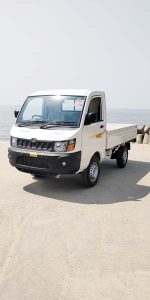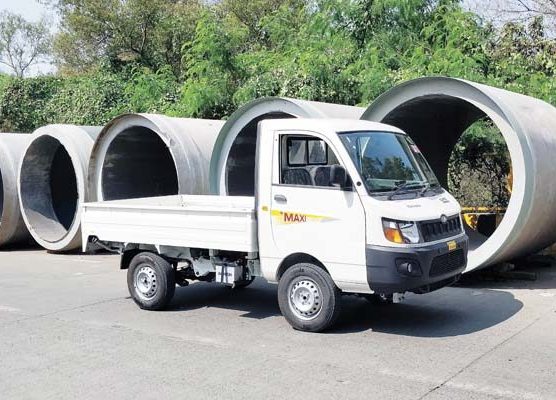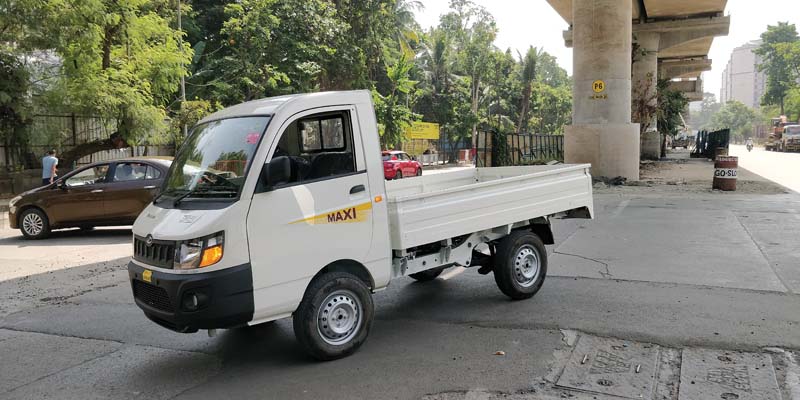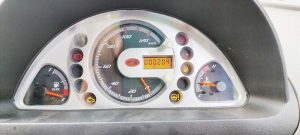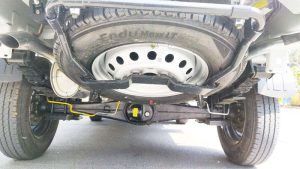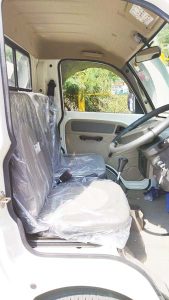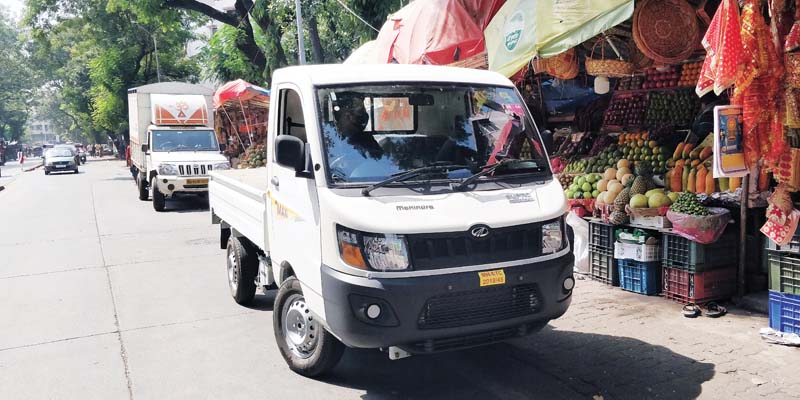Mahindra & Mahindra is banking on the revamped Supro SCV range to offer prospective customers a significant upgrade. Ashish Bhatia and Prateek Pardeshi checked on the claims.

Mahindra & Mahindra (M&M) tested waters with the revamped Supro Small Commercial Vehicle (SCV) range first in July 2021. The Original Equipment Manufacturer (OEM) launched the near identical twin scvs, the Supro Profit Truck maxi and the Supro Profit Truck Mini. As the name suggests, with the revamped range, the Maxi range consisting of the Maxi LX, Maxi VX (PS), Maxi (PS+AC), Maxi CBC and the Maxi High Deck variants with the mini counterparts are claimed to offer higher profit. Higher profit amounting to 25-36 per cent by way of low Total Cost of Ownership (TCO), higher load carrying capacity, higher mileage and a higher power to weight ratio. According to Veejay Nakra, Chief Executive Officer at Mahindra & Mahindra Ltd., the company is claimed to have significantly enhanced the product proposition by focussing on delivering a class leading performance, fuel efficiency coupled with the choice of diesel and Compressed Natural Gas (CNG) powertrains. From the range, we got our hands on the Supro Profit Truck maxi VX – Bharat Stage VI (BSVI) Diesel, priced initially at Rs.6.22 lakh (Ex-showroom, Mumbai).
The profit truck
The BSVI Supro Maxi VX (Maxi VX), a notch above the base variant (Maxi LX), was handed over to us in the diamond white shade. M&M also offers customers the choice between the crimson red and lakeside brown colours. the shade of white stood as a barrier between the full blown sun and us and so we aren’t complaining. Albeit, the VX sans the Heating Ventilation, and Air Conditioning (HVAC) on the lower end of the spectrum meant we got a taste of what it would be like for its prospect pilot to go back to the grind on a daily basis in typical hot and humid conditions like that of Mumbai or any other coastal region on different duty cycles. Built at the M&M Chakan plant, the maxi truck is claimed to have undergone rigorous and full test cycle runs to validate the Unique Selling Points (USPs) of performance, safety and reliability. The Maxi VX stays true to its genes with similarities from the earlier generations featuring prominently on the new variant. m&m has upped the ante on the new variant by offering a class leading warranty of three years or 80,000 km (whichever is earlier). Especially with the heavy-duty variant launched in early 2018 that boasted of stronger aggregates and a higher earning potential too. Back then, the company offered a two years or 60,000 km warranty in comparison to the 2021 variant.
The discomfort driven by the sultry weather was partially offset with the new Maxi VX turning heads even before we set off on our road check route. For starters, the characteristic pronounced snout in the semi-forward truck continues to withstand the test of time. The 220 mm frontal nose design doesn’t look outdated! The vertical slat grille has a fine mesh with rhombus shaped openings running as the backdrop. It flaunts the old arrangement of the clear lens lamps that run up to the A-pillar. The body coloured bumper from the higher variants was amiss and stood out like a sore thumb when we had the top-end competitor variants run past it in the same frame. Not an apple for apple comparison, when looked at in isolation, the exclusion does not take away from the utilitarian aspect on offer even at this end of the lineup. On the higher end of the variants, the day cabin is complemented with a body coloured bumper, and a HVAC unit that is claimed to enhanced driver comfort and draw more customers to the & stable.
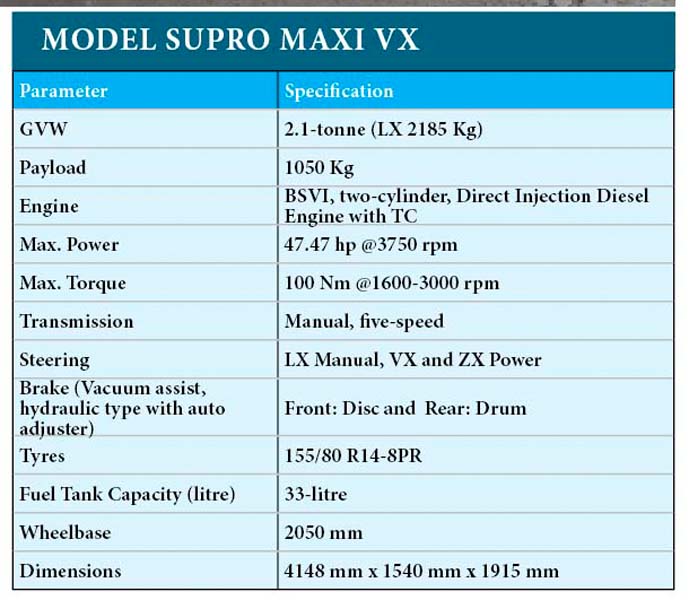 Walk over to the side, and it is clear that the Maxi VX holds its ground with its glossy paint job, an attractive badging on the doors much like its predecessors, and a visibly long load tray. The side repeaters come as standard fitments on either side close to the B-pillar in order to notify other road users of the drivers turn intentions. The Maxi VX is backed by claims of robust aggregates too. A touch and feel of the load tray, for instance, is a testimony of the Maxi being a workhorse. It draws from the pickup legacy of the M&M in turn to suit its own customer profile. The Maxi VX comes with a higher rated payload of up to 1.1-tonne (1100 kgs) made possible with the inclusion of a 8.2 ft. by 5.05 ft. cargo tray accessible from the rear. It is 10 per cent higher compared to competition as per company claims. The tray gets company welded rope mounting points on the periphery to fasten the open cargo. Chances of going along rust free are high given the coat of body coloured paint sprayed over it.
Walk over to the side, and it is clear that the Maxi VX holds its ground with its glossy paint job, an attractive badging on the doors much like its predecessors, and a visibly long load tray. The side repeaters come as standard fitments on either side close to the B-pillar in order to notify other road users of the drivers turn intentions. The Maxi VX is backed by claims of robust aggregates too. A touch and feel of the load tray, for instance, is a testimony of the Maxi being a workhorse. It draws from the pickup legacy of the M&M in turn to suit its own customer profile. The Maxi VX comes with a higher rated payload of up to 1.1-tonne (1100 kgs) made possible with the inclusion of a 8.2 ft. by 5.05 ft. cargo tray accessible from the rear. It is 10 per cent higher compared to competition as per company claims. The tray gets company welded rope mounting points on the periphery to fasten the open cargo. Chances of going along rust free are high given the coat of body coloured paint sprayed over it.
The Maxi sits on bigger R14 radials with a 2050 mm wheelbase giving. It has a high ground clearance of 196 mm to take on both tarmac and lose soil making it a good fit for diverse terrians. The one we drove was fitted with a set of the Apollo Endu Maxx 165 R 14 LT 97/95 R tyres. The Apollo Endu Maxx is a familiar inclusion on the 1.25- and 1.7-tonne Mahindra Bolero ExtraLong as well as on the 1.5-tonne Bolero Extrastrong. The high quality fibre mud flaps over the rear wheel lacked its pair on the front. Those looking for it can easily opt for an aftermarket alternative though.
A squat further reveals the drivetrain powering the Supro. It’s easy to notice the leaf spring type suspension made up of eight leaves at the front and seven leaves at the rear. Under it is the stepney placed at an incline to facilitate a healthy departure angle. The rear bumper houses the tail light and the reflector in a rectangular arrangement. There are rubber bushes placed along the bumper’s periphery to dampen the impact from the tailgate collapse. It also houses the rear sensors which alert proximity to an object of concern. The placement could however pose an issue if the driver were to reverse with an open tailgate. In effect, the sensor stands to be obstructed and perhaps malfunction when looking to prevent a rear collision.
The driveability
Its non-exerting to hop into SCVs like the Maxi VX compared to the pull required to be exerted in higher tonnage vehicles for reasons well known. once seated, it is apparent how M&M has strived to offer passenger vehicle-like comfort and balance it to offer the commercial vehicle-like utility to the pilot like the maxi is meant to. Two is company and three is a crowd holds good here with the gear stick dividing the seating in a D + 1 arrangement that could squeeze in another driver cum helper. On settling down, the windshield offers a good central, peripheral and side vision for enhanced visibility. The test unit also carried a badge of the 24×7 ‘Mahindra with you Hamesha’ toll free helpline with coordinates alongside the BSVI badge for that added assurance. On looking closer, we noticed a smart design inclusion by way of the placement of a two-nozzle washer on the left wiper that exhibits an integrated wiper design approach. It should serve well as intended.
Lower your chin, and attention to the interiors is drawn by a digital clock at first. Placed at the centre of the dashboard, the dedicated timer is a welcome standard inclusion in contrast to the fine script font, found in most instrument clusters. The latter are often blocked by the glaring sun making them a safety hazard especially in day rides, and if the pilot were to be completely dependent on it for clocking the trips. Overall, the two tone trims (beige and black) run through the cabin including on the seats, lending to the appealing aesthetics of the Maxi VX
Keeping it simple, the OEM has ticked most boxes. From three-point retractable seat belts, grab bars, manual scroll up windows, to pull-locks being placed ergonomically on the doors on either side. The power steering gives a clear view of the analog instrument cluster that houses a simple, semi-circular arrangement. When compared to electric SCVs it seems a far cry from the modern digital consoles and might be an area that can be looked at if such ICE variants and their EV counterparts are to co-exist. It is perhaps to also do with the customer mind-set in the respective segment where less is deemed more. The good old analog console in the Maxi houses the speedo flanked by key indicators on either side akin to rotary dials in a retro design touch. These are in turn flanked by the fuel gauge on one side and the oil gauge on the other.
The Maxi truck is zippy from the word go. The two-spoke power steering is very responsive albeit for new drivers the positioning between the clutch and brake levers could need some adjustment initially. Coupled with a low turning radius of 5.2 m, once used to the driver’s ergonomics, including the miniscule pedals, it is easy to negotiate tight corners with a passenger vehicle like ease. On straight stretches, albeit, being a CV, the speed governor locked all the excitement to 80 kmph. Within this range (0-80 kmph), we were able to ply the Maxi on both open tarmacs, and in a congested market, areas to test its capabilities. We came out impressed and did not experience much drag. Neither did we experience a rattling sound associated with CVs despite being in an unladen state barring the occasional bumps courtesy an empty tray. With no access to the fully loaded variant and the preferred laden state, we reserve our final verdict though on the Noise, Vibration and Harshness (NVH) levels. A key consideration for long haul drives especially considering the use of SCVs beyond intra-city trips in charting intercity routes too.
The Maxi has enough fire in its belly as it draws sufficient power from its 909 cc (14 per cent higher compared to the competition), two-cylinder, BSVI diesel, Direct Injection (DI) engine with turbocharge. It offers a choice between an ‘Eco’ and a ‘Power’ mode. The engine develops ~47 hp of peak rated power (seven per cent higher) at 3750 rpm and a peak rated torque of 100 Nm
(nine per cent lower compared to the competition) at 1600-3000 rpm. The latter ensures the availability of power at lower rpms. The air snorkel placed right behind the cabin ensures the apt mix of air and fuel to prevent a scenario of engine knocking. This enhances the overall engine efficiency. The engine on the Supro Maxi truck is mated to a new, five-speed (5+R), a manual synchromesh transmission that aids in fatigue-free and well-controlled drives.
Smooth gear shifts allowed us to slip into higher gears with relative ease on straights and facilitated downshifting in congested market areas with bumper to bumper traffic. The vacuum-assisted hydraulic type X split brakes with dual Load Sensing Proportional Valve (LSPV) with an auto adjuster, served well offering a safe braking distance to the vehicle ahead on our multiple attempts. The Maxi is fitted with disc brakes on the front and drum at the rear. It is claimed to offer a mileage of 21.94 kmpl (12 per cent higher compared to competition) in a 20 per cent improvement over competition. Compared to diesel, we feel the CNG powertrain is likely to experience an even greater traction with the owner cum driver community.
Also read, Mahindra announces Corona insurance on Bolero pick-ups range



